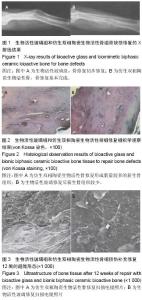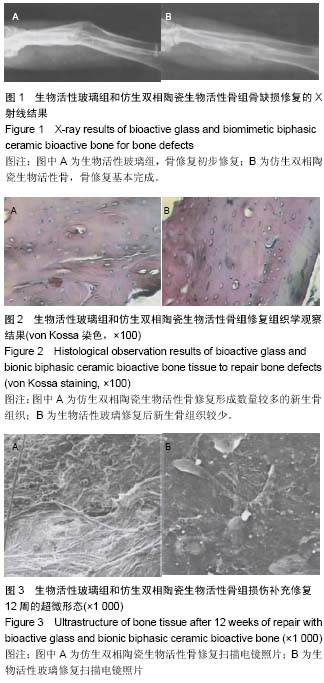| [1] 臧继传,修晓光,曹斌,等.两种仿生双相陶瓷生物骨的异位成骨作用[J].中国组织工程研究与临床康复,2007,11(1):45-47.
[2] 彭吾训,王蕾,李彦林,等.双相陶瓷生物活性骨的制备及其细胞相容性研究[J].中国矫形外科杂志,2008,16(19):1496-1498.
[3] 李彦林,韩睿,钟玲,等.双相陶瓷样生物骨的生物相容性[J].中国组织工程研究与临床康复,2008,12(45):8801-8804.
[4] 朱晓松,李彦林,郭洪涛,等.双相陶瓷样生物骨修复骨缺损[J].中国组织工程研究与临床康复,2009,13(8):1450-1454.
[5] 张守平,修晓光,孙莉莉,等.两种仿生双相陶瓷生物骨修复节段性骨缺损[J].中国组织工程研究与临床康复,2009,13(34): 6655- 6658.
[6] 何伟.纳米双相陶瓷人工骨的制备和实验研究[D].武汉:湖北中医学院,2009.
[7] 柴云峰,白峰,马朵.BMP和VEC复合磷酸钙陶瓷人工骨修复大段骨缺损的研究[J].延安大学学报(医学科学版),2009,7(3): 12-13, 16.
[8] 彭吾训,王蕾,邓进,等.一种组织工程骨修复兔股骨头坏死模型的效果评价[J].第三军医大学学报,2010,32(7):661-664.
[9] 赵玫,吴海珍,王鑫,等.牙源性双相陶瓷的研制及其骨缺损修复实验[J].安徽医科大学学报,2013,48(6):617-620.
[10] 姚彪,钱卫庆,尹宏,等.新型α-半水硫酸钙/双相生物陶瓷人工骨修复兔桡骨骨缺损的X射线评估[J].中国组织工程研究,2014, (47):7550-7555.
[11] 王福科,李彦林,王国梁,等.复合骨形成蛋白和碱性成纤维细胞生长因子的双相陶瓷样生物活性骨修复指骨缺损[J].中国组织工程研究与临床康复,2010,14(47):8885-8888.
[12] 杨为中,周大利,尹光福,等.骨组织工程支架材料磷酸钙双相生物陶瓷的研究进展[J].硅酸盐学报,2004,32(9):1143-1149.
[13] 卢晓风,李胜富,张杰,等.HA/TCP双相陶瓷与人成骨细胞生物相容性的体外实验研究[J].生物医学工程学杂志,2001,18(4): 497-499.
[14] Pinheiro AL, Santos NR, Oliveira PC, et al. The efficacy of the use of IR laser phototherapy associated to biphasic ceramic graft and guided bone regeneration on surgical fractures treated with wire osteosynthesis: a comparative laser fluorescence and Raman spectral study on rabbits. Lasers Med Sci. 2013;28(3):815-822.
[15] Wu CC, Yang KC, Yang SH, et al. In vitro studies of composite bone filler based on poly(propylene fumarate) and biphasic α-tricalcium phosphate/hydroxyapatite ceramic powder. Artif Organs. 2012;36(4):418-428.
[16] Froum SJ, Wallace SS, Cho SC, et al. Histomorphometric comparison of a biphasic bone ceramic to anorganic bovine bone for sinus augmentation: 6- to 8-month postsurgical assessment of vital bone formation. A pilot study. Int J Periodontics Restorative Dent. 2008;28(3):273-281.
[17] Schwarz F, Herten M, Ferrari D, et al. Guided bone regeneration at dehiscence-type defects using biphasic hydroxyapatite + beta tricalcium phosphate (Bone Ceramic) or a collagen-coated natural bone mineral (BioOss Collagen): an immunohistochemical study in dogs. Int J Oral Maxillofac Surg. 2007;36(12):1198-1206.
[18] 李彦林,曹彬,陈建明,等.双相陶瓷样生物活性骨修复的临床初步应用[C]//第五届全国骨科新理论、新技术、新材料研讨会论文集,2010:78-83.
[19] 王光军,张娇,章庆国.表面改性双相陶瓷复合自体骨髓干细胞修复兔骨缺损的实验研究[J].现代生物医学进展,2007,7(6): 849-852.
[20] 庄景义,彭吾训.组织工程骨BCBB/BMP/bFGF的成骨作用观察[J].贵阳医学院学报,2014,39(3):320-323.
[21] 彭吾训,王蕾,李彦林,等.BCBB/BMP/bFGF复合物在股骨头坏死修复中的成血管作用观察[J].山东医药,2010,50(10):32-33.
[22] 卢晓风,卢冰,张杰,等.HA/TCP双相陶瓷肌内长期植入诱导成骨的实验观察[J].生物医学工程学杂志,2002,19(3):361-364.
[23] 彭吾训,王蕾,邓进,等.BCBB/BMP/bFGF复合物修复股骨头坏死模型的成骨观察[J].中国现代医学杂志,2010,20(19): 2917-2921.
[24] 郑德宇,张玉华,姚素艳,等.人骨形态发生蛋白2基因转染的骨髓基质细胞复合生物活性玻璃陶瓷修复颅骨缺损[J].中国组织工程研究与临床康复,2009,13(34):6705-6708.
[25] 周先略,杨宗珍,徐靳,等.异体复合陶瓷化骨粉修复种植牙骨缺损的应用研究[J].临床口腔医学杂志,2005,21(7):396-397.
[26] 彭吾训,王蕾,李彦林,等.双相陶瓷生物骨的制备和性能检测[J].陕西医学杂志,2009,38(11):1470-1472.
[27] 王光军.表面改性双相陶瓷复合自体骨髓基质干细胞修复兔骨缺损的实验研究[D].南京:东南大学,2007.
[28] Pinheiro AL, Santos NR, Oliveira PC, et al. The efficacy of the use of IR laser phototherapy associated to biphasic ceramic graft and guided bone regeneration on surgical fractures treated with miniplates: a Raman spectral study on rabbits. Lasers Med Sci. 2013;28(2):513-518.
[29] 刘屹林,刘宏建,宋跃明,等.多孔双相陶瓷复合重组人骨形态发生蛋白-2和碱性成纤维细胞生长因子缓释微球的生物相容性[J].中华实验外科杂志,2010,27(7):964-966.
[30] 张骏.新型双相陶瓷支架与兔骨髓间充质干细胞相容性研究[D].南京:东南大学,2007.
[31] 熊亮,谭金海,方芙蓉,等.多孔碳酸钙陶瓷修复骨缺损的生物力学评价[J].武汉大学学报(医学版),2008,29(1):13-16.
[32] 郭洪涛.组织工程化双相陶瓷生物骨修复兔桡骨节段性缺损的研究[D].昆明:昆明医学院,2007.
[33] 修晓光.双相陶瓷生物骨的研制及成骨研究[D].昆明:昆明医学院, 2005.
[34] 聂玮,何伟.纳米双相陶瓷人工骨的成骨及降解[J].中国组织工程研究,2013,17(12):18-25.
[35] 龙厚清,李佛保,王迎军,等.三种钙磷陶瓷材料复合重组人骨形成蛋白-2体内成骨的研究[J].中国修复重建外科杂志,2003,17(3): 180-184.
[36] 朱明华,曾怡,孙涛,等.生物陶瓷及其BMP和TGF复合物修复节段性骨缺损及成骨效应的研究[J].北京生物医学工程,2007, 26(4):401-407,424.
[37] 钱卫庆.BCP/HAFG-rhBMP-2复合人工骨修复骨缺损的实验研究[D].南京:东南大学,2007.
[38] 龙厚清,李佛保,王迎军,等.新型双相陶瓷材料复合成骨细胞构建人工骨及其体内成骨的观察[J].骨与关节损伤杂志,2003,18(6): 391-394.
[39] 薛双丽,包崇云.骨诱导性双相磷酸钙陶瓷的研究与应用[J].中国组织工程研究,2013,17(47):8235-8241.
[40] 郑军,汤伟忠,齐新生.新型双相钙磷陶瓷复合骨形态发生蛋白及碱性成纤维细胞生长因子修复兔骨缺损[J].中国组织工程研究与临床康复,2010,14(42):7791-7794.
[41] 张聪,姚一民,冯怀志,等.多孔生物活性陶瓷治疗骨缺损(附40例临床应用报告)[J].西南国防医药,2003,13(3):274-276.
[42] 郑启新,郭晓东,刘勇等.bFGF基因修饰的间充质干细胞/多孔β-TCP陶瓷复合移植修复兔节段性骨缺损[J].中国生物医学工程学报,2003,22(2):171-177.
[43] 姚彪,钱卫庆,尹宏.新型α-半水硫酸钙/双相生物陶瓷人工骨修复兔桡骨骨缺损的X射线评估[J].中国组织工程研究,2014,18(47): 7550-7555.
[44] Pinheiro AL, Aciole GT, Ramos TA, et al. The efficacy of the use of IR laser phototherapy associated to biphasic ceramic graft and guided bone regeneration on surgical fractures treated with miniplates: a histological and histomorphometric study on rabbits. Lasers Med Sci. 2014;29(1):279-288.
[45] Bodde EW, Wolke JG, Kowalski RS, et al. Bone regeneration of porous beta-tricalcium phosphate (Conduit TCP) and of biphasic calcium phosphate ceramic (Biosel) in trabecular defects in sheep. J Biomed Mater Res A. 2007;82(3):711-722.
[46] 王光军,张俊,刘斌,等.涂层双相陶瓷复合BMSC修复骨缺损的实验观察[J].组织工程与重建外科杂志,2008,4(2):73-76.
[47] 赵玫.牙源性双相陶瓷的研制及其骨缺损修复实验[D].合肥:安徽医科大学,2013.
[48] 徐卫国,陈安民,黄传勇,等.修复长骨大段骨缺损的ZrO增韧HA陶瓷研究[J].武汉理工大学学报,2004,26(4):45-48.
[49] 张长青,袁霆,曾炳芳,等.富血小板血浆促进骨缺损修复的实验研究[J].中国修复重建外科杂志,2003,17(5):355-358.
[50] 刘瑞丽,吴学建,王利民,等.多孔双相陶瓷复合重组人骨形态发生蛋白-2和碱性成纤维细胞生长因子缓释微球的异位成骨活性[J].中华实验外科杂志,2011,28(7):1045-1047.
[51] 周献伟,孙勇.纳米磷酸钙陶瓷人工骨治疗跟骨骨缺损的X线评价[J].中国医师杂志,2011,13(5):676-677.
[52] 郑德宇,杨依勇,赵凯,等.生物玻璃活性陶瓷复合人骨形态发生蛋白2基因修饰骨髓间充质干细胞修复颅骨缺损[J].中国组织工程研究与临床康复,2010,14(42):7807-7810.
[53] 王蕾,彭吾训,张爱华,等.双相陶瓷生物骨-骨形态发生蛋白-碱性成纤维细胞生长因子复合物修复股骨头坏死模型的实验研究①[J].中国康复理论与实践,2013,19(5):426-431.
[54] 王丽丽.复合性生物活性陶瓷在颌骨囊肿骨缺损修复中的应用[J].黑龙江医药,2012,25(1):140. |

